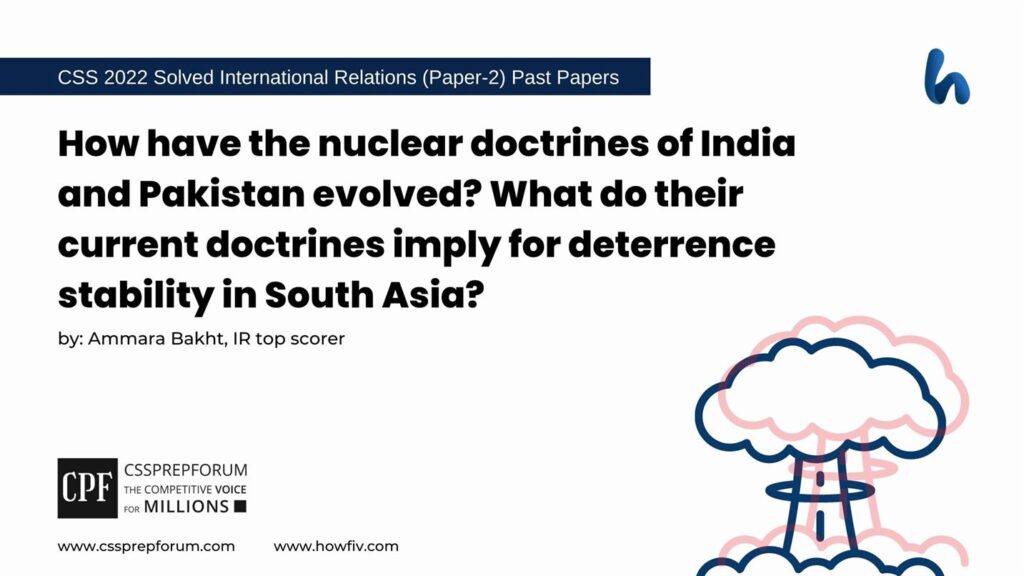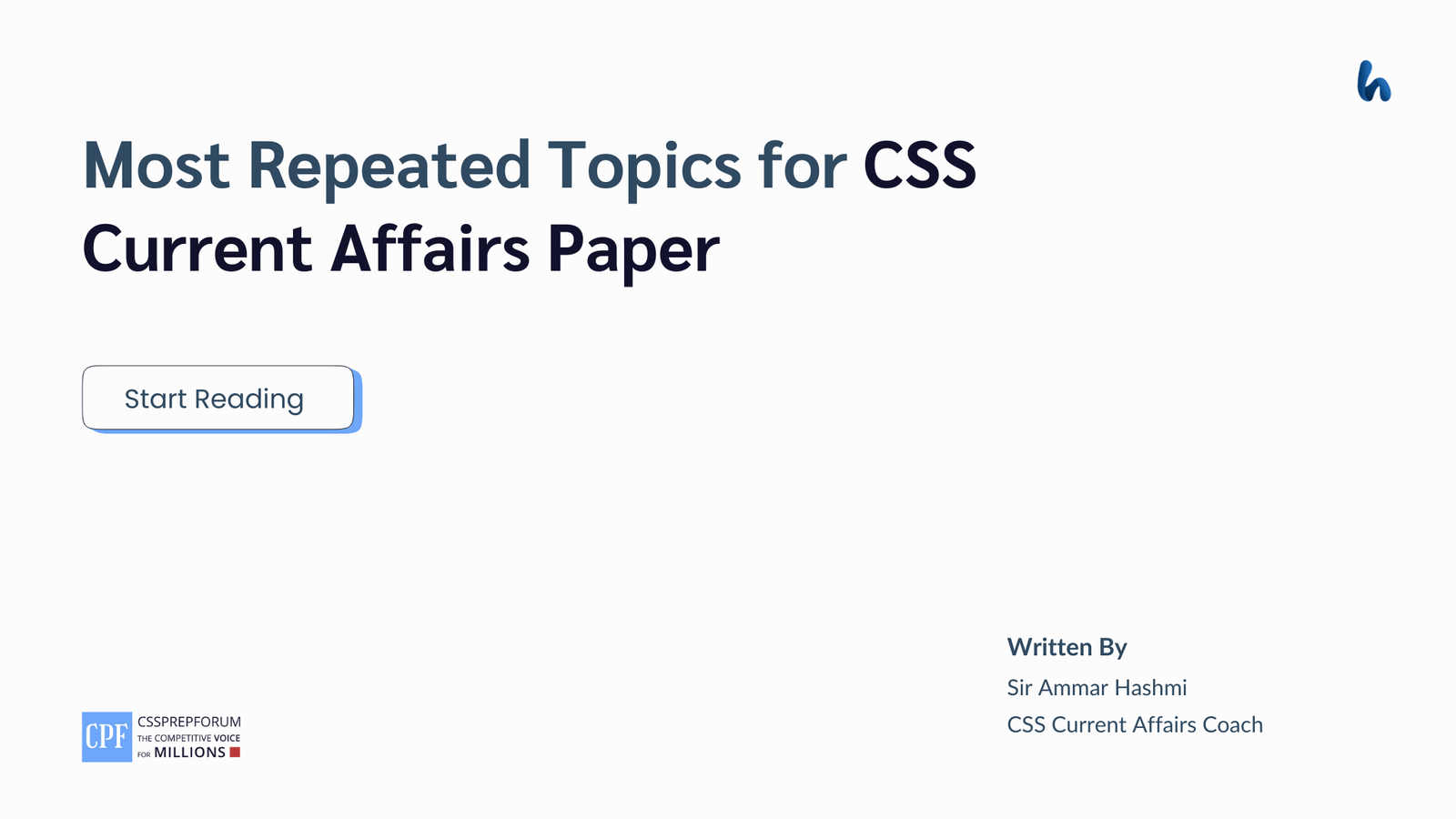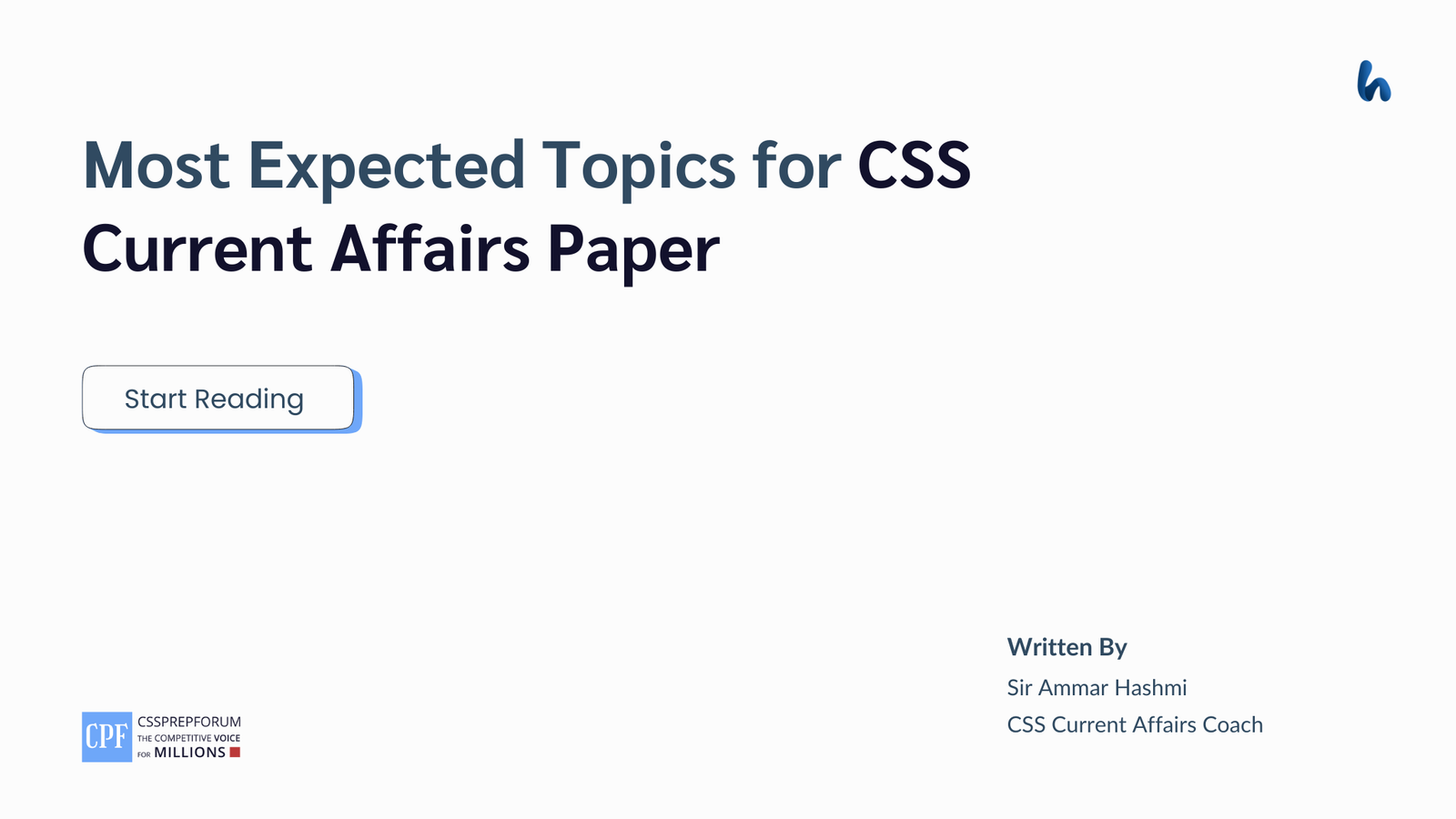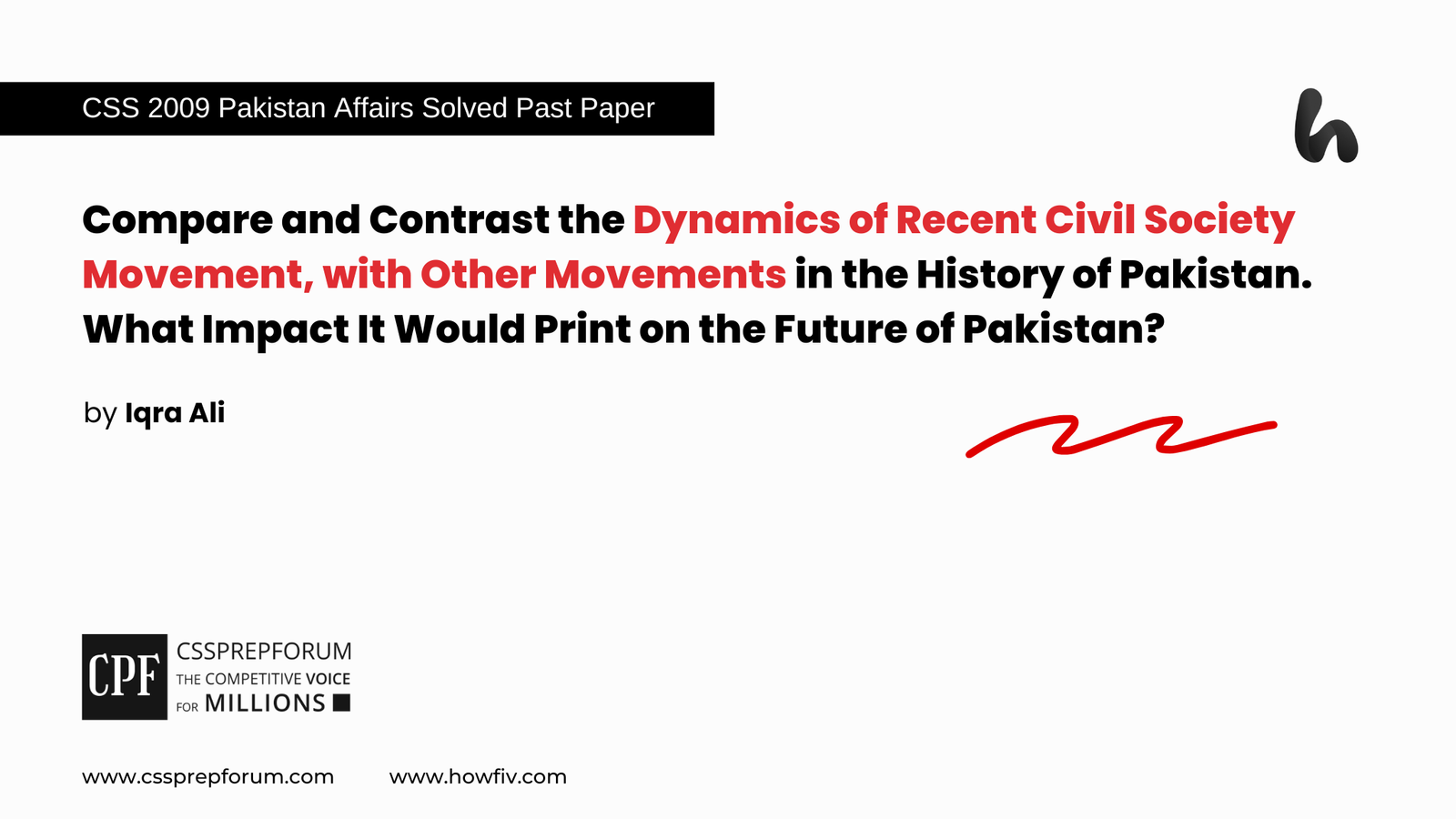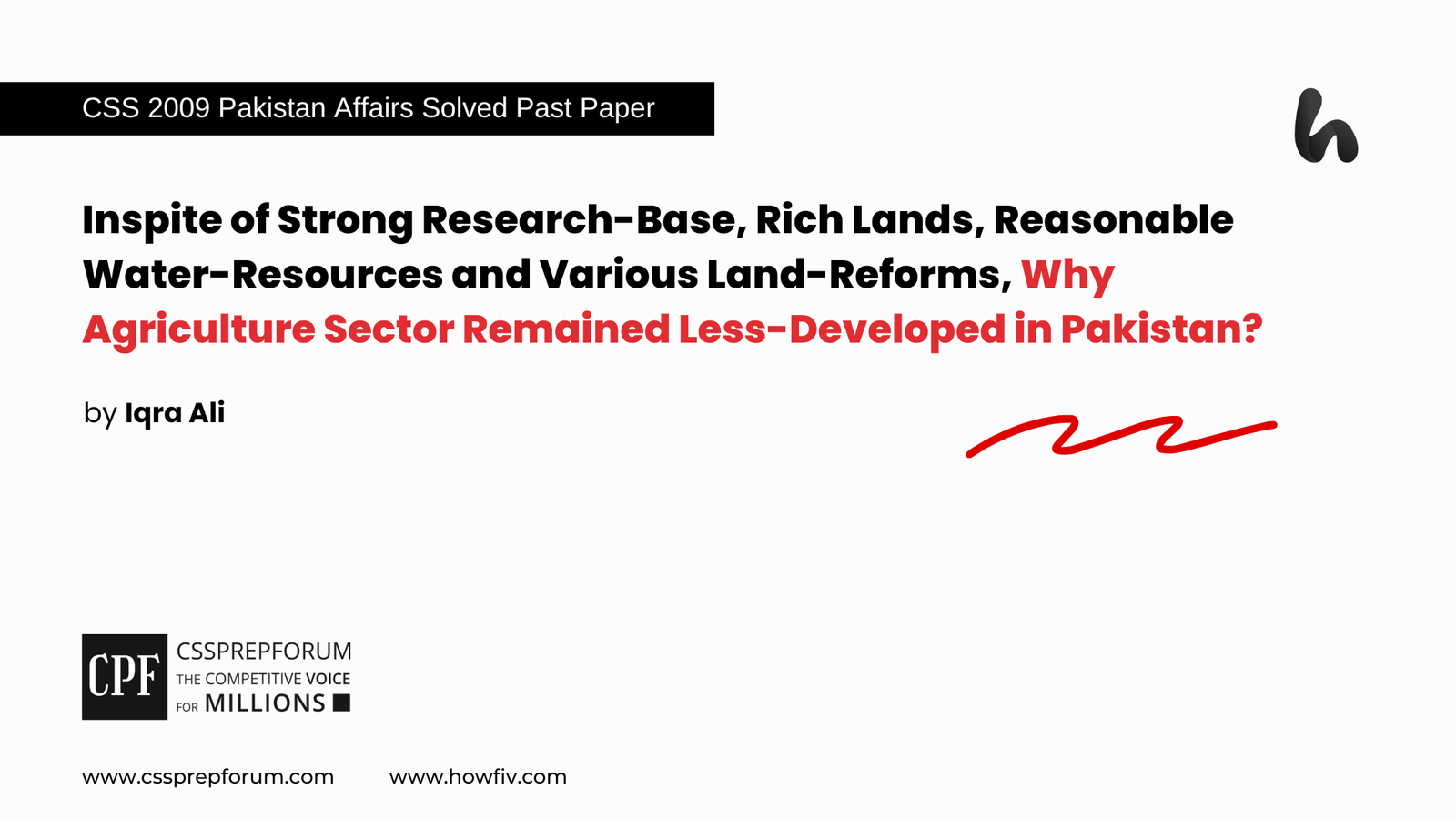CSS Solved International Relations Past Paper 2022 | How have the nuclear doctrines of India and Pakistan evolved? What do their current doctrines imply for deterrence stability in South Asia
Ammara Bakht, the highest scorer in the CSS IR paper, attempts the following question. The question is attempted in the same way that Miss Abeera Fatima, the top IR scorer, has been attempting. Moreover, the answer is written on the same pattern, taught by Sir to his students, scoring the highest marks in compulsory subjects for years. This solved past paper question is uploaded to help aspirants understand how to crack a topic or question, how to write relevantly, what coherence is, and how to include and connect ideas, opinions, and suggestions to score the maximum.

Question Breakdown
In this question, the examiner has asked about the evolution of Pak-India nuclear doctrines… You have to explain doctrines and their policy change w.r.t. time and need. In, addition to this you have to explain what these doctrines imply for stability and progress in the South Asian Region. You also have to give recommendations in this regard.
Outline
1- Introduction
2- Nuclear Doctrine
3- Nuclear Doctrine and South Asia
4- Evolution of Nuclear Doctrines in India and Pakistan
- ✓ Development of Pakistan’s Nuclear Doctrine
- Establishment of Nuclear Program 1956-74
- Contributions of Dr Abdul Qadir Khan 1975-1998
- After nuclear test 1998-2007
- ✓Advancement in India’s Nuclear Doctrine
- A brief timeline of nuclear weapons development in India
- Policy shift From No first use to Preemption
3- Comparison of Nuclear Doctrines
4- Indo-Pak and deterrence stability in the region
- ✓ Recommendations
4- Critical analysis
5- Conclusion
Answer to the Question
Introduction
Nuclear Doctrine is the determination of state,s owned nuclear weapon declaratory policy, force structure and diplomacy. The South Asian region has been a hub of conflicts since its rival states possessed nuclear capabilities that include, including India, Pakistan and their neighbour China. India has the older nuclear program whereas Pakistan began working on nuclear weapons after 1974. In the late 70s Dr Abdul Qadir Khan was working in the URENCO enrichment plant, in the Netherlands, in 1975 he returned to Pakistan to work on a Uranium enrichment program to serve his homeland. By 2000 Pakistan adopted its doctrine that has no NFU and is preempted to respond in any aggressive conflict. Currently, India has also switched from NFU to preemption which can be dangerous for the peace of the region.
Nuclear Doctrine
It encompasses the missions and goals that are required to guide the use and deployment of nuclear weapons. It also determines state,s owned nuclear weapon declaratory policy, force structure and diplomacy. The most dominant goals of this doctrine include allies and their assurance, deterrence, and hedge against unfortunate future and destruction of the target.
Nuclear Doctrine and South Asia
The South Asian region has been a nuclear flashpoint since its rival states possessed nuclear capabilities that include, India, Pakistan and their neighbour China. In case of India and Pakistan, both share a long history of skirmishes, grievances, distrust and territorial conflict. Their acquirement of nuclear weapons is driven by their urge to counter each other in the region. In 1999, during the Kargil war, the International community trembled due to escalated tensions between the two nuclear states and tried to lessen tensions between them. As even a misunderstanding can heat the conflict to a nuclear war. So nuclear doctrines guide the states in their nuclear responses.
Evolution of Nuclear Doctrines in India and Pakistan
India has the older nuclear program among the two whereas Pakistan began working on nuclear weapons after 1974 when India tested its Smiling Budha ( nuclear weapon). Not only India and Pakistan, but China also has a major role in pursuing nuclear weapons.
India was accepted as a nuclear-capable state after its Pokhran-II tests that were conducted in May 1998. In response to that, Pakistan also conducted its nuclear tests on 28 May of the same year and became Nuclear capable state in the region.
It possesses a developing a nuclear arsenal. It has remained aside from NPT (Non-proliferation treaty) and CTBT (Comprehensive Nuclear Test Ban Treaty). It is the only country that has blocked negotiations with FMCT (Fissile Material Cut-Off Treaty).
- ✓ Development of Pakistan’s Nuclear Doctrine
A. Establishment of Nuclear Program 1956-1974
The inception of the program lies in the adverse relationship between the two countries. They have been involved in hate-hate relationships since 1947. Pakistan started its nuclear program in the 1950s and made Pakistan Atomic Energy Commission in 1956. President Zulfiqar Ali Bhutto advocated this development and famously said in 1965
“If India builds the bomb, we will eat grass or leaves, even go hungry, but we will get one of our own”
After the defeat of 1971, Bhutto was strictly instructed to build nuclear weapons within three years. India’s first testing in 1974 has motivated Pakistan to build a nuclear weapon of its own.
B. Contributions of Dr Abdul Qadir Khan 1975-1998
Dr Abdul Qadir Khan worked in the URENCO enrichment plant, in the Netherlands, in 1975 he returned to Pakistan to work on the Uranium enrichment program. At that time PAEC was headed by Munir Ahmad Khan and the development was inefficient because of export control over nuclear weapons.
By continuous dedication and hard work of A.Q.Khan, in the early 1980s Pakistan, attained a Uranium enrichment facility. Islamabad also received assistance and help from China at various levels like centrifuge equipment, missile assistance and other technical expertise.
In 1998 after demonstrating its nuclear capability, Pakistan moved quickly towards the formulation of a Nuclear Doctrine. Contrary to the popular belief that Pakistan doesn’t possess any nuclear doctrine, it had its doctrine ready even before the Indian nuclear doctrine, which was pronounced in 1999.
C. After the nuclear test 1998-2007
This doctrine was ready and accepted unanimously by the military and political leadership in early 1999 when its formal approval was heckled because of the Kargil war in late 1999. At the closure of the Kargil crisis, India pronounced its Indian Nuclear Doctrine and Pakistan held back its announcement due to certain reasons. Later on, when, the command and control structure along with doctrine was approved and decided to pronounce, 9/11 occurred. The government decided to hold back its announcement once again, because of the terrified international community and intense International pressure.
President Pervez Musharraf stated in 2002 that,
“Nuclear weapons are aimed solely at India,” and would only be used if “the very existence of Pakistan as a state”
Moreover, the continued war in Afghanistan during the past two decades has raised more security concerns both internally and externally and it has deteriorated the situation for the worse. These adverse situations have kept this doctrine unveiled up till now.
Pakistan’s doctrine is a theoretical notion of the military that promotes deterrence by Active and aggressive retaliation as an aggressive action against the opponent. It was mentioned that its nuclear policy is India-centric and is constructed as a response to security concerns. The other objectives such as prestige in the International community are of secondary importance.
- ✓Advancement in India’s Nuclear Doctrine
India’s nuclear doctrine NFU (No First Use) has evolved over the years. It has gone through a number of stages as shown in fig 1. It was first declared by Nuclear Security Advisory Board in 1999 and has been considered a basic building block of its nuclear doctrine.
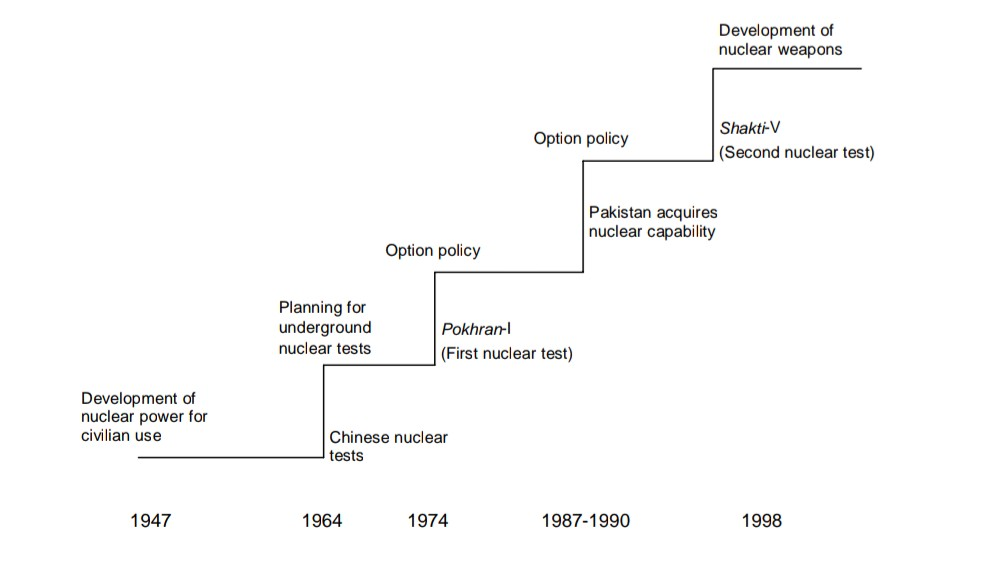
A. A brief timeline of nuclear weapons development in India
Since its inception, India has been putting much effort into the development of Nuclear power generation. It constructed its first nuclear reactor in 1956 with the technical assistance of Canada and the USA. With minute progressions and after China’s nuclear test in 1964, India was motivated and in the period of 10 years, conducted its first nuclear test Pokhran-I in 1974.
It was considered a peaceful nuclear explosion, which retained its capability to develop biological weapons in future. Indian government clarified on several occasions that they don’t have any intention to develop any nuclear weapon but just wanted to test their potential, which they called “option policy.”
Amid minor skirmishes between India and Pakistan in the 1970s and 80s Indian PM instructed to begin full-scale development of nuclear weapons and carried out the first ballistic missile test AGNI in 1989. NPT and CTBT finally pushed India from an option policy towards nuclear testing.
B. Policy shift From No first use to Preemption
India’s NFU was adopted in 1999 by Nuclear Security Advisory Board (NSAB) in Draft Nuclear Doctrine (DND) that became the basis of the Indian Nuclear Doctrine. Recently, developments and changes in politics have shown that India has shifted its policy from NFU to preemption. The shift seems to be purely Pak-centric as per the statement given by the Indian Defense minister in 2019. Amid tensions in the South Asian region, this shift to preemption can have drastic effects, challenging stability in the region.
Comparison of Nuclear Doctrines
Comparison and recent changes in Pakistan and Indian Nuclear Doctrine is given in table
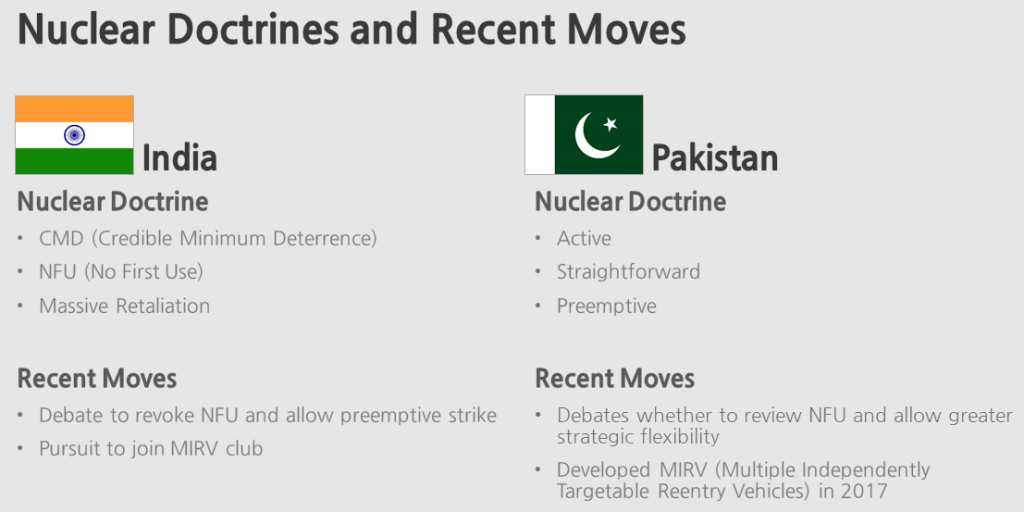
Indo-Pak and deterrence stability in the region
- Indo-Pak hostile relationship left asymmetries and acute scarcities in their nuclear doctrines which are exacerbated by disbelief, military capabilities and prolonged absence of mutual dialogue. Desmond Bowen, Antoine Levesques and John H. Gill presented a detailed research study which showed that continuous instability between these two nations can take them to the point where they can mistakenly or imprudently use these weapons. This could lead to the failure of nuclear deterrence and the outcome would be drastic and catastrophic.
- Both countries are chasing new techniques and technologies in nuclear weapons. Although they possess a sufficient amount of weapons to ensure deterrence. Their expansion policies in nuclear weaponry can call into question the minimalistic policies and arms race in a post-pandemic era.
- Only India and Pakistan are capable of overcoming the challenges faced by risk-reducing measures. Robust, deniable, reliable and trusted backchannel between both states can secure nuclear deterrence stability in the region. This could help to mitigate future risks and will help India and Pakistan build new trust bonds
- ✓ Recommendations
Experts have identified some of CBMs (Confidence building measures) to improve the bond between India and Pakistan and improve stability in the region. Some of them are mentioned below
- Revision of 1988 agreement that is Prohibition of Attack against Nuclear Installations and Facilities.
- Establish a few nuclear risk reduction centres.
- Withdraw nuclear-capable, outdated short-range ballistic missiles.
- Missile-testing pre-notification regime upgradation.
- Sustainability of Bilateral discussions on defence.
- Sustainability of Bilateral discussions on nuclear stability.
- Sustainability of backchannel for catastrophes and crises management and their resolutions.
- Join the IAEA and its existing arrangement on fissile-material confidence building.
Critical Analysis
Islamabad and Delhi are searching for new techniques and capabilities that threaten the opponent’s defence mechanism. It means they are still the rivals of South Asia thirsty for each other’s blood. Indian change of policy from NFU to pre-emption says it all. Whereas, Pakistan’s nuclear doctrine promotes deterrence by assuring an abrupt “massive retaliation” as an aggressive counterattack against the state. This is not only alarming for both the states but also for the South Asian region. It can have unimaginable effects, if not returned towards mild policy provisions.
Conclusion
South Asian region has suffered a lot since 1947. Both states have an intense hatred for each other. Both became nuclear states one after the other to retaliate on the dot. Researchers have deeply studied their doctrines and mentioned the drawbacks and flaws in them and their applicability. So, some of the CBMs are mentioned to promote peace, development, and harmony among nations. They are necessary for the harmonization of the region and its development.


CSS Solved Past Papers’ Essays
Looking for the last ten years of CSS and PMS Solved Essays and want to know how Sir Kazim’s students write and score the highest marks in the essays’ papers? Then, click on the CSS Solved Essays to start reading them.
CSS Solved Essays

CSS Solved General Science & Ability Past Papers
Want to read the last ten years’ General Science & Ability Solved Past Papers to learn how to attempt them and to score high? Let’s click on the link below to read them all freely. All past papers have been solved by Miss Iqra Ali & Dr Nishat Baloch, Pakistan’s top CSS GSA coach having the highest score of their students.
General Science & Ability Solved Past Papers
CSS Solved Pakistan Affairs Past Papers
Want to read CSS Pakistan Affairs Solved Past Papers and learn how to attempt them to score high? Let’s click on the link below to read them all freely. All past papers’ questions have been attempted by Sir Kazim’s students, who scored the highest in the subject.
CSS Solved Pakistan Affairs
CSS Solved International Relations’ Past Papers
Have you opted for International Relations in the CSS examination and want to score above 150? Then, click on the CSS Solved International Relations’ Past Papers by Miss Abeera Fatima, the top IR scorer and the best IR coach in Pakistan.
CSS Solved International Relations Past Papers
Articles Might Interest You!
The following are some of the most important articles for CSS and PMS aspirants. Click on any to start reading.

